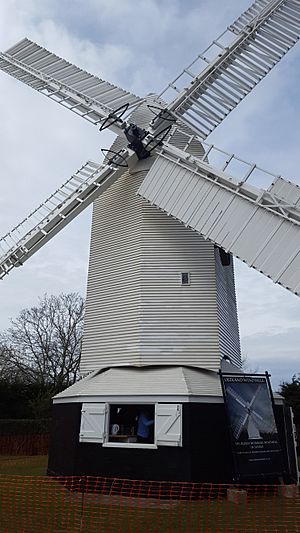Oldland Mill, Keymer facts for kids
Quick facts for kids Oldland Windmill, Keymer |
|
|---|---|

The mill during an Open Day 2016
|
|
| Origin | |
| Grid reference | TQ 32118 16210 |
| Coordinates | 50°55′49″N 0°07′17″W / 50.93022°N 0.12134°W |
| Year built | c1700 |
| Information | |
| Purpose | Corn mill |
| Type | Post mill |
| Roundhouse storeys | Single storey roundhouse |
| No. of sails | Four |
| Type of sails | Spring sweeps |
| Windshaft | Cast iron |
| Winding | Tailpole |
| Auxiliary power | Steam |
| No. of pairs of millstones | Two pairs, arranged Head and Tail |
Oldland Windmill is a very old windmill located near Keymer, a village in West Sussex, England. It's a special type of windmill called a post mill, and it's so important that it's listed as a Grade II building, meaning it's protected for its history. This amazing mill has been around for centuries, helping to grind corn into flour.
Contents
The Mill's Long History
Oldland Windmill was built around the year 1700. The first records of a windmill in this area date back to 1703. When it was first built, it was an "open trestle" mill, which means its main support structure was open to the elements. The roundhouse, which is the building at the bottom, was added later on.
Records show that a mill stood in Keymer in 1755. It was also marked on a map from 1783. However, it wasn't shown on a map from 1795, which is a bit of a mystery! Later, the mill was recorded in 1801, but then left off maps again in 1813 and 1829. Luckily, a more detailed map did show it. We know for sure the mill was working in 1828. Oldland Mill continued to grind grain using wind power until 1912.
Falling Apart and Being Saved
After 1912, the mill started to fall apart. It got worse and worse over the early 1900s. In 1927, the Sussex Archaeological Society took over the mill. They had some repairs done in 1934.
Years later, in 1976, people started talking about how to save Oldland Mill. It was in really bad shape. In 1977, experts checked the mill and found it was close to collapsing!
A Big Restoration Project
In 1979, the Hassocks Amenity Association started working with the Sussex Archaeological Society. In 1980, the association leased the mill. This began a huge project to restore the mill, mostly done by volunteers!
Since then, the mill has received grants and a lot of work has been completed. Volunteers did almost all of it. They took the mill apart and built many new pieces to replace the old, rotten ones. The entire mill was covered with new wood. By October 2007, the four big "sweeps" (the arms with sails) were put back in place.
In October 2008, the mill ground its first batch of corn in many decades! After some final adjustments, the windmill now grinds flour regularly. It's one of the few windmills in Sussex that can sell flour. Oldland Mill is the oldest working windmill in Sussex. Today, volunteers from the Oldland Mill Trust, a charity, look after it.
In 2015, the mill's original steam engine system was fixed. This meant that for the first time in over 100 years, steam power was used to help run the mill!
How the Mill Was Restored
The first group of volunteers started working on August 2, 1980. They cleaned up rubbish around the mill and fixed the roundhouse roof temporarily. In 1981, the last two sweeps were removed with help from sailors.
In 1983, a special "A" frame was built to support the main shaft that holds the sweeps. Over the next ten years, much of the mill's wooden frame was replaced. This included the main support structure and other important parts.
In 2006, a new large wheel, about 8 feet 8 inches (2.64 meters) wide, was built. This wheel is made of elm wood with hornbeam teeth and oak arms. It helps the millstones turn.
What Oldland Mill Looks Like
Oldland Mill is a post mill. This means the entire top part of the mill, which holds the machinery, can turn on a central post to face the wind. It sits on a single-story, eight-sided roundhouse. The roundhouse is made of tarred brick with wooden weatherboarding on top.
The mill has four "spring sweeps," which are the arms that hold the sails. It is turned into the wind using a long wooden pole called a "tailpole." The main shaft that connects the sweeps to the gears is made of cast iron. It was made in 1873. Inside, there are two pairs of millstones, which are the big stones that grind the corn.
Millers Who Worked Here
Many millers have worked at Oldland Windmill over the years, grinding corn for the local community. Here are some of them:
- George Bennett (around 1819 - 1828)
- Joseph Roots Beard (1828 - 1840)
- Joseph Winchester (around 1839 - 1860)
- Thomas Ashdown (1860 - 1869)
- Jesse Washington White (1869 - 1891)
- John Turner (around 1878 - 1895)
- John White (around 1894 - 1904)
- David Driver (around 1891 - 1912)
Gallery






